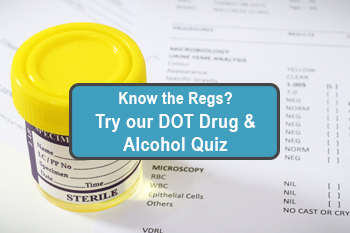Common Pitfalls To Managing Your Drug And Alcohol Program – Part 2
posted in Alerts, Blog by Brian Gray
Common Pitfalls To Managing Your Drug And Alcohol Program – Part 2
Article by CleanFleet
DOT focuses on the rules, not what you think is common sense
This is our second installment of calling attention to common drug and alcohol testing mistakes, guided by well-meaning but ill-formed “common sense,” that can leave your company and your driver at risk for an acute, refusal to test violation. In this episode, we will talk about the failures on the side of the collector that lead to refusal to test violations.
Every year, the Federal Motor Carrier Safety Administration (FMCSA) has authorized and set the testing rate for both drug and alcohol testing for motor carriers and consortiums.  These testing rates have remained unchanged for the past 30 years: 50% of a pool of drivers must be randomly chosen and tested for drug use and 10% must have their breath-alcohol concentration tested. Carriers and consortiums have met this requirement by managing their random selections in one of two ways: either by making one random selection for drug testing and another for BAT (Breath Alcohol Testing) or by making a selection for drug use and then randomly choosing 10% of the drug testing applicants to also undergo BAT.
These testing rates have remained unchanged for the past 30 years: 50% of a pool of drivers must be randomly chosen and tested for drug use and 10% must have their breath-alcohol concentration tested. Carriers and consortiums have met this requirement by managing their random selections in one of two ways: either by making one random selection for drug testing and another for BAT (Breath Alcohol Testing) or by making a selection for drug use and then randomly choosing 10% of the drug testing applicants to also undergo BAT.
Many carrier or consortium choose to use the second method because it reduces the amount of authorizations and chains of custody that must be managed. The downside of using this method is that some collectors are so used to handling single authorizations – and usually for drugs, not alcohol – that when they get an order for both drugs and alcohol, they fail to test for the latter.
Why is this important for you? Don’t count on your collector to read and implement your authorization correctly just because they are DOT certified. And while you should also inform your driver what kind of tests they will be taking, unless your DER personally accompanies all of your drivers to the collection site, don’t count on your driver to carry out your authorization correctly either. Finally, if you are using a consortium to direct you to an appropriate collection site, be aware that they might send your driver to a site that is only equipped to test for drugs but that cannot perform a BAT. Any of these lapses in attention can lead to a driver getting a positive test result for unwittingly refusing to test if they arrive at a testing site with an authorization for both drug and alcohol testing.
How can you avoid this pitfall? When it comes to drug and alcohol testing, assume nothing and verify everything. Make sure your DER schedules testing at a clinic with the ability to perform both tests. Review with your drivers what tests they will undergo before they leave your office and tell them to call your DER immediately if a test is not performed. It is the expectation of DOT audiors that the driver and DER understand when and if a test was completed. If it was not, it is incumbent upon the carrier to get the driver to the nearest testing facility as expeditiously as possible to perform the test.
At CleanFleet, all our collectors are certified to perform both DOT drug tests and DOT Breath-Alcohol Tests. CleanFleet’s operations staff also offers assistance to DER(s) to help them find appropriate testing sites near their driver’s location and our customer care staff will review your paperwork and work with your DER to make sure all testing is properly completed. Don’t allow lack of understanding to result in the stiff penalties associated with a refusal to test. We can help.








